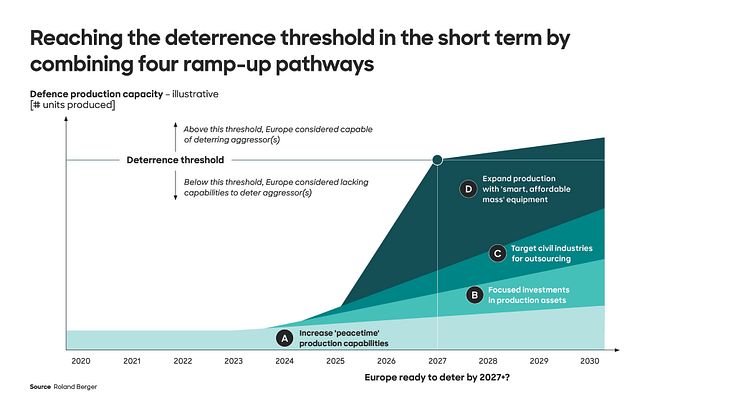
Press release -
Roland Berger Defence Study: How Europe can Achieve Deterrence by 2030
- Roland Berger publishes defence study and positions itself as a strategic partner to support Europe’s necessary defence transformation
- Coordinated, pan-European action among policymakers, defence companies, and non-defence industries is essential to meet new warfare paradigms and secure Europe’s resilience
- Europe could be ready to produce industrial output needed to reach the deterrence threshold and discourage potential aggressors by 2030
Munich, May 2025: The world is experiencing shifting power dynamics and a heightened sense of urgency for national and international security efforts. European defence budgets are rising amid these escalating geopolitical threats, but achieving sustainable deterrence requires more than financial resources. It requires a holistic approach that combines industrial innovation, agile manufacturing, and cross-sector collaboration to meet the demands of modern warfare. The study “The defence imperative: Driving innovation and resilience on Europe’s path to strategic autonomy” identifies four industrial pathways critical to reaching the ‘deterrence threshold’— defined as the industrial output needed to discourage potential aggressors.
“The security landscape in Europe has shifted dramatically,” says Kai Balder, Partner at Roland Berger. “Europe must unite its defence and civilian industries, build scalable production capabilities and embrace high-volume, affordable and software-defined technology. The task is daunting, but Europe’s capacity for innovation and partnership makes it achievable.”
Reaching the deterrence threshold in the short term through four ramp-up pathways
The authors introduce the concept of the ‘deterrence threshold’, which captures the industrial capacity needed to sustain and replenish Europe’s defence equipment – even in a ‘new world’ context where both legacy platforms and emerging capabilities must coexist. The study assumes a 25 percent increase in Russia’s defence output between 2024 and 2030, along with an extra 10 percent output needed to outmatch Russia to ensure credible deterrence. Based on this, the study outlines exemplary production targets for three key capabilities: artillery rounds, main battle tanks, and air/sea-launched subsonic cruise missiles. According to the calculations, Europe could target 2.9 million artillery rounds annually, exceeding Russia’s estimated 2.7 million in 2030. Similarly, Europe must target an annual output of 370 main battle tanks that would surpass Russia’s combined annual output of around 340 in 2030 and must strive for 1,380 cruise missiles, outmatching Russia’s estimated 1,250 per year in 2030.
To achieve these targets and other required capability increases, the study identifies four interconnected industrial pathways:
- Increasing peacetime production capabilities
- Focused investment in production assets to modernize existing lines
- Collaboration with civil industries
- Expanding production with smart, affordable, mass solutions
The integration of these pathways is essential for Europe to address both legacy and emerging security challenges.
The authors name five key enablers that will allow Europe to reach the deterrence threshold: Firstly, the defence equipment offering must be enlarged by robotized and unmanned systems to complement human forces. Secondly, the industrial agility to quickly make capacities available needs to be increased. Furthermore, a technology/software approach to stay ahead of multi-domain threats should be fostered. Another point of action is streamlining acquisition processes among European countries to build deterrence capabilities rapidly. And lastly, civil-military integration needs to be intensified to take full advantage of dual-use capacities.
A coordinated, pan-European effort is needed
The study authors emphasize the need for coordinated actions among the three main stakeholder groups: Policymakers and military agencies, defence industry players, and non-defence industry players. They propose recommendations for each that aim to reinforce cooperation, address remaining capability constraints and secure a sustainable deterrence threshold. Europe’s defence industry must modernize existing production lines to swiftly increase output while collaborating with civilian industries to resolve supply chain bottlenecks and boost high-volume manufacturing. For instance, partnerships with sectors like automotive and electronics could help address critical supply chain constraints. In addition, civil industries could benefit from further commercial growth opportunities in defence, especially considering growth challenges in their core businesses.
“Europe’s defence ecosystem must adapt to the ‘new world’ of warfare by embracing radical change,” says Kai Balder, Partner at Roland Berger. “Europe's defence technology and industrial base will need to gear up for this multifaceted, modern warfare threats. Civil innovators will be key partners in ensuring agility and cost-efficiency.”
Topics
Categories
Roland Berger is one of the world's leading strategy consultancies with a wide-ranging service portfolio for all relevant industries and business functions. Founded in 1967, Roland Berger is headquartered in Munich. Renowned for its expertise in transformation, innovation across all industries and performance improvement, the consultancy has set itself the goal of embedding sustainability in all its projects. Roland Berger generated revenues of around 1 billion euros in 2024.



